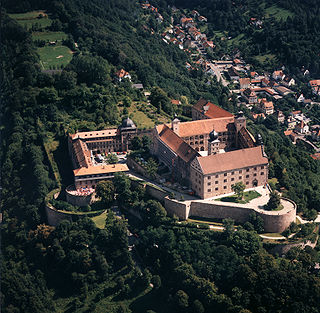
Albert II was the margrave of Brandenburg-Kulmbach (Brandenburg-Bayreuth) from 1527 to 1553. He was a member of the Franconian branch of the House of Hohenzollern. Because of his bellicose nature, Albert was given the cognomen Bellator during his lifetime. Posthumously, he became known as Alcibiades.

George Frederick of Brandenburg-Ansbach was Margrave of Ansbach and Bayreuth, as well as Regent of Prussia. He was the son of George, Margrave of Brandenburg-Ansbach and a member of the House of Hohenzollern. He married firstly, in 1559, Elisabeth of Brandenburg-Küstrin. He married secondly, in 1579, Sophie of Brunswick-Lüneburg, daughter of William of Brunswick-Lüneburg and Dorothea of Denmark.

The House of Hohenzollern is a formerly royal German dynasty whose members were variously princes, electors, kings and emperors of Hohenzollern, Brandenburg, Prussia, the German Empire, and Romania. The family came from the area around the town of Hechingen in Swabia during the late 11th century and took their name from Hohenzollern Castle. The first ancestors of the Hohenzollerns were mentioned in 1061.

Hof is a town on the banks of the Saale in the northeastern corner of the German state of Bavaria, in the Franconian region, at the Czech border and the forested Fichtel Mountains and Franconian Forest upland regions. The town has 47,296 inhabitants, the surrounding district an additional 95,000.

Kulmbach is the capital of the district of Kulmbach in Bavaria in Germany. The town, once a stronghold of the Principality of Bayreuth, is renowned for its University of Life Sciences, a branch of the University of Bayreuth, the massive Plassenburg Castle, which houses the largest tin soldier museum in the world, for its brewery, its vivid food industry, which hosts some of the world's biggest food businesses, and for its sausages, or Bratwürste.

The Principality of Bayreuth or Margraviate of Brandenburg-Bayreuth was an immediate territory of the Holy Roman Empire, ruled by a Franconian branch of the Hohenzollern dynasty. Since Burgrave Frederick VI of Nuremberg was enfeoffed with the Margraviate of Brandenburg in 1415/17, the Hohenzollern princes transferred the margravial title to their Franconian possessions, though the principality never had been a march. Until 1604 they used Plassenburg Castle in Kulmbach as their residence, hence their territory was officially called the Principality of Kulmbach or Margraviate of Brandenburg-Kulmbach until the Empire's dissolution in 1806.

Plassenburg is a castle in the city of Kulmbach in Bavaria. It is one of the most impressive castles in Germany and a symbol of the city. It was first mentioned in 1135. The Plassenberg family were ministerial of the counts of Andechs and used as their seat the Plassenburg. The House of Guttenberg, a prominent Franconian noble family, traces its origins back to 1149 with a Gundeloh v. Blassenberg (Plassenberg). The name Guttenberg is derived from Guttenberg and was adopted by a Heinrich von Blassenberg around 1310. From 1340, the Hohenzollerns governed from Plassenburg castle their territories in Franconia till 1604. The Plassenburg was fortress and residence for the Hohenzollerns.

Casimirof Brandenburg-Bayreuth was Margrave of Bayreuth or Margrave of Brandenburg-Kulmbach from 1515 to 1527.

Christian, Margrave of Brandenburg-Bayreuth was a member of the House of Hohenzollern and Margrave of Brandenburg-Kulmbach.
The Second Margrave War was a conflict in the Holy Roman Empire between 1552 and 1555. Instigated by Albert Alcibiades, Margrave of Brandenburg-Kulmbach and Brandenburg-Bayreuth, who was attempting to form a Duchy of Franconia under his rule, the war resulted in widespread devastation in Franconia, while also affecting the Rhineland and Lower Saxony.

Johannes Voigt was a German historian born in Bettenhausen, which today is situated in the district of Schmalkalden-Meiningen.

Georg Albrecht of Brandenburg-Bayreuth, was a German prince and member of the House of Hohenzollern.

Marie of Brandenburg-Kulmbach was a Princess of Brandenburg-Kulmbach and by marriage Electress Palatine.

Emilie of Saxony was Margravine of Brandenburg-Ansbach as the third wife of Margrave George the Pious of Brandenburg-Ansbach. Since his two earlier wives died before his accession, she was the only one to hold the title of Margravine.
Henry V of Plauen was Burgrave of Meissen and Lord of Plauen and Voigtsberg.

Henry IV of Plauen, was High Chancellor of the Kingdom of Bohemia, Burgrave of Meissen, Lord of Plauen, Gera, Greiz, Schleiz and Bad Lobenstein, Lord of Toužim, Hartenštejn Castle, Andělská Hora Castle and Žlutice. He also used the traditional title of Lord of Lázně Kynžvart and, apart from an intermezzo in 1547, he was Lord of Bečov nad Teplou as well.

The House of Kotzau was an old minor German noble family in Franconia, Germany.

The siege of Hof was an event of the Second Margrave War. The city of Hof was successfully besieged in 1553 by the opponents of the Margrave Albert II Alcibiades of Brandenburg-Kulmbach.
The Bavarian War from 1459 to 1463, also known as the Princes' War, was a result of the expansionist ambitions of the two warring Principalities, pitting Margrave, later Elector, Albert Achilles from the House of Hohenzollern, which by this time had already annexed the principalities of Brandenburg-Kulmbach and Brandenburg-Ansbach, against Duke Louis "the Rich" of Bavaria-Landshut from the House of Wittelsbach.

Weigand of Redwitz was Prince-Bishop of Bamberg from 1522 until his death.


















